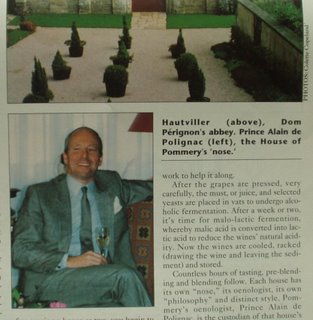
There's a whole lot of riddling and shaking going on in eastern France.
Less than two hours' drive from Paris, in deep, ancient chalk pits, some dating back to the Gallo-Roman era, millions of bottles are being turned daily by the deft wrist-work of the riddlers. We're in Champagne and riddling is a step in the process that takes anywhere from three to 12 years, culminating in those wonderful bottles of bubbly most people break out only on special occasions.
But not in Champagne. Here it's not uncommon to drink it like wine -- one for every course. Imagine this sparkling meal for a moment: With an appetizer of fresh foie gras of goose or Petrossian caviar, comes a crisp Ultra-Brut. Then with your main course of fish or veal ... no, make that a scallop-lobster-leek pie in tender flaky pastry... a not-so-Brut.
With a cheese course, a Rosé, barely pink and barely sweet. For dessert, instead of just one, how about La Symphonie des desserts, a little of everything? No problem, we'll have the whole orchestra. And more of that Rosé. And wouldn't we all quaff champagne if we could buy it at their prices, and eat what the champenois eat? With gastronomy like theirs, who needs to see Naples and die. You can eat and drink Champagne and die happier still.
The province is dominated by the champagne industry and the large houses with almost mythical names like Pommery, Heidsieck, Moët et Chandon. Roederer, a number of smaller producers like Krug and Billecart-Salmon, and a host of others. They are spread in and around Epernay and the city of Reims, in whose cathedral 25 kings of France were crowned. The vineyards cover the hills and valleys of three main areas which produce, under strict controls, the grapes that go into the blending of this precious liquid: white chardonnay, pinot noir and pinot meunier, flourishing in a soil peculiar to this area.
Picker, riddler, enologist or tour guide, everyone working in the production of champagne seems to do it with great gusto. Marie-France Beck exemplifies the passion of those in the business. When she first started working at Heidsieck, she was asked how long she intended to say. "Oh, a couple of years," she said blithely. Today, 25+ years later she is still here.
Life here is a drama of soil and grapes, gastronomy and passion, and a history as rich as that foie gras that melts on your tongue almost on contact. (After dining in the area's restaurants, you might feel your own liver would make a good foie gras --now you can appreciate why the French drink so much bottled water.)
[edit: Then comes a lot of technical stuff which I've omitted, and dinner with the Prince de Polignac, the House of Pommery's "nose" and a direct descendant of Louise de Pommery, the widow behind the Pommery House.]
Of course, a trip to Champagne doesn't come cheap, but you do get what you pay for and if it's a gastronomic vacation you want, you'll get something your sense will never forget. Every morsel, every bubble will blur into a lingering culinary memory, a Babette's Feast in more luminous surroundings.
Text and photography (c) Colette Copeland

I visited France today...and drank the finest champagne! Thank you Colette...Bless You friend.
ReplyDeletec'est parfait! Your desrciption of this part of France and their life style regarding Champagne is wonderful. I am second home sick!
ReplyDelete